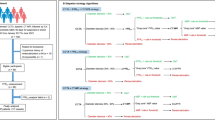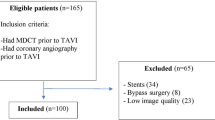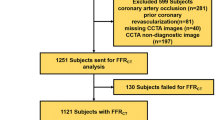Abstract
Objective
This study aims to investigate the safety and feasibility of using a deep learning algorithm to calculate computed tomography angiography–based fractional flow reserve (DL-FFRCT) as an alternative to invasive coronary angiography (ICA) in the selection of patients for coronary intervention.
Materials and methods
Patients (N = 296) with symptomatic coronary artery disease identified by coronary computed tomography angiography (CTA) with stenosis over 50% were retrospectively enrolled from a single centre in this study. ICA-guided interventions were performed in patients at admission, and DL-FFRCT was conducted retrospectively. The influences on decision-making by using DL-FFRCT and the clinical outcome were compared to those of ICA-guided care for symptomatic CAD at the 2-year follow-up evaluation.
Result
Two hundred forty-three patients were evaluated. Up to 72% of diagnostic ICA studies could have been avoided by using a DL-FFRCT value > 0.8 as a cut-off for intervention. A similar major adverse cardiovascular event (MACE) rate was observed in patients who underwent revascularisation with a DL-FFRCT value ≤ 0.8 (2.9%) compared to that of ICA-guided interventions (3.3%) (stented lesions with ICA stenosis > 75%) (p = 0.838).
Conclusion
DL-FFRCT can reduce the need for diagnostic coronary angiography when identifying patients suitable for coronary intervention. A low MACE rate was found in a 2-year follow-up investigation.
Key Points
• Seventy-two percent of diagnostic ICA studies could have been avoided by using a DL-FFRCT value > 0.8 as a cut-off for intervention.
• Coronary artery stenting based on the diagnosis by using a 320-detector row CT scanner and a positive DL-FFRCT value could potentially be associated with a lower occurrence rate of major adverse cardiovascular events (2.9%) within the first 2 years.
• A low event rate was found when intervention was performed in tandem lesions with haemodynamic significance based on DL-FFRCT < 0.8 as a cut-off value.


Similar content being viewed by others
Abbreviations
- CABG:
-
Coronary artery bypass surgery
- CAD:
-
Coronary artery disease
- CCTA:
-
Coronary computed tomography angiography
- CFD:
-
Computed fluid dynamics
- DL-FFRCT:
-
Deep learning–based FFRCT
- FFR:
-
Fractional flow reserve
- FFRCT:
-
Coronary computed tomography angiography (CCTA)-derived fractional flow reserve
- ICA:
-
Invasive coronary angiography
- LAD:
-
Left anterior descending artery
- MACEs:
-
Major adverse cardiovascular events
References
Patel MR, Nørgaard BL, Fairbairn TA et al (2019) 1-year impact on medical practice and clinical outcomes of FFRCT. JACC Cardiovasc Imaging:2978
Douglas PS, De Bruyne B, Pontone G et al (2016) 1-year outcomes of FFRCT-guided care in patients with suspected coronary disease. J Am Coll Cardiol 68(5):435
Tanaka K et al (2016) Comparison between non-invasive (coronary computed tomography angiography derived) and invasive-fractional flow reserve in patients with serial stenoses within one coronary artery: a NXT trial substudy. Ann Biomed Eng 44(2):580–589
Tesche C et al (2018) Coronary CT angiography–derived fractional flow reserve: machine learning algorithm versus computational fluid dynamics modeling. Radiology 288(1):64–72
Coenen A et al (2018) Diagnostic accuracy of a machine-learning approach to coronary computed tomographic angiography–based fractional flow reserve. Circ Cardiovasc Imaging 11(6):e007217
Tesche C et al (2019) Influence of coronary calcium on diagnostic performance of machine learning CT-FFR: results from MACHINE registry. JACC Cardiovasc Imaging
Qiao HY et al (2020) Impact of machine learning–based coronary computed tomography angiography fractional flowreserve on treatment decisions and clinical outcomes in patients with suspected coronary artery disease. Eur Radiol 30(11):5841–5851
Scanlon Patrick J et al (1999) ACC/AHA guidelines for coronary angiography: executive summary and recommendations. Circulation 99(17):2345–2357
Liu X et al (2019) Evaluation of fractional flow reserve in patients with stable angina: can CT compete with angiography? Eur Radiol 29(7):3669–3677
Gao Z, Wang X, Sun S et al (2020) Learning physical properties in complex visual scenes: An intelligent machine for perceiving blood flow dynamics from static CT angiography imaging. Neural Netw 123:82–93
Kim HJ et al (2010) Patient-specific modeling of blood flow and pressure in human coronary arteries. Ann Biomed Eng 38(10):3195–3209
Tu S et al (2014) Fractional flow reserve calculation from 3-dimensional quantitative coronary angiography and TIMI frame counta fast computer model to quantify the functional significance of moderately obstructed coronary arteries. J Am Coll Cardiol Intv 7(7):768–777
Xu P et al (2018) Assessment of boundary conditions for CFD simulation in human carotid artery. Biomech Model Mechanobiol 17(6):1581–1597
Gao Z et al (2017) Automatic segmentation of coronary tree in CT angiography images. Int J Adapt Control and Signal Process. https://doi.org/10.1002/acs.2762
Liu X et al (2017) Hemodynamics analysis of the serial stenotic coronary arteries. Biomed Eng Online 16(1):127
Wang X et al (2018) Functional assessment of stenotic coronary artery in 3D geometric reconstruction from fusion of intravascular ultrasound and x-ray angiography. IEEE Access 6:53330–53341
Tonino PAL et al (2010) Angiographic versus functional severity of coronary artery stenoses in the FAME study. J Am Coll Cardiol 55(25):2816
Hlatky MA et al (2015) Quality-of-life and economic outcomes of assessing fractional flow reserve with computed tomography angiography. J Am Coll Cardiol 66(21):2315
Douglas PS et al (2015) Clinical outcomes of fractional flow reserve by computed tomographic angiography-guided diagnostic strategies vs. usual care in patients with suspected coronary artery disease: the prospective longitudinal trial of FFRCT: outcome and resource impacts study. Eur Heart J 36(47):3359–3367
investigators TS-H (2015) CT coronary angiography in patients with suspected angina due to coronary heart disease (SCOT-HEART): an open-label, parallel-group, multicentre trial. Lancet 385(9985):2383–2391
Fairbairn TA et al (2018) Real-world clinical utility and impact on clinical decision-making of coronary computed tomography angiography-derived fractional flow reserve: lessons from the ADVANCE Registry. Eur Heart J 39(41):3701–3711
Lu MT et al (2017) Noninvasive FFR derived from coronary CT angiography management and outcomes in the PROMISE trial. JACC Cardiovasc Imaging 10(11):1350
Jensen JM et al (2017) Computed tomography derived fractional flow reserve testing in stable patients with typical angina pectoris: influence on downstream rate of invasive coronary angiography. Eur Heart J Cardiovasc Imaging 19(4):405–414
Xu PP et al (2020) The influence of image quality on diagnostic performance of a machine learning–based fractional flow reserve derived from coronary CT angiography. Eur Radiol 30(5):2525–2534
West AM, Beller GA (2010) 256-and 320-row coronary CTA: is more better? Oxford University Press
Hsiao EM, Rybicki FJ, Steigner M (2010) CT coronary angiography: 256-slice and 320-detector row scanners. Curr Cardiol Rep 12(1):68–75
Tesche C, Gray HN (2020) Machine learning and deep neural networks applications in coronary flow assessment: the case of computed tomography fractional flow reserve. J Thorac Imaging 35
Modi BN et al (2019) Predicting the physiological effect of revascularisation in serially diseased coronary arteries. Circ Cardiovasc Interv 12(2):e007577
Sakuma H (2019) Coronary CT angiography fractional flow reserve analysis: a practical tool or a luxury for research centers? Radiology 292(3):606–607
Packard RRS et al (2016) Fractional flow reserve by computerised tomography and subsequent coronary revascularisation. Eur Heart J Cardiovasc Imaging 18(2):145–152
Gaur S et al (2016) Coronary plaque quantification and fractional flow reserve by coronary computed tomography angiography identify ischaemia-causing lesions. Eur Heart J 37(15):1220–1227
Acknowledgements
We thank the clinical support by Dr. Zeyu Xiao. We thank Keya medical (Shenzhen, Guangdong, China) for providing the support of deep learning-based CT-FFR product.
Funding
This study is supported by grand from Guangzhou Science and Technology Plan Project (Grant Number: 201807010046), Guangzhou Key Laboratory of Molecular and Functional Imaging for Clinical Translation (Grant Number:201905010003), Natural Science Foundation of Guangdong Province, China (Grant Number: 2019A1515011463), the Science and Technology Planning Project of Guangdong Province, China (Grant Number: 2018A050506031, 2019B010110001), the National Natural Science Foundation of China (Grant Number: 61771464, U1801265, 82001910), and Medical Scientific Research Foundation of Guangdong Province of China (Grant Number: A2018132).
Author information
Authors and Affiliations
Corresponding author
Ethics declarations
Guarantor
The scientific guarantor of this publication is Changzheng Shi.
Conflict of interest
The authors report no relationships that could be construed as a conflict of interest.
Statistics and biometry
No complex statistical methods were necessary for this paper.
Informed consent
Written informed consent was obtained.
Ethical approval
Institutional Review Board approved the present study.
Methodology
• retrospective
• observational
• performed at one institution
Additional information
Publisher’s note
Springer Nature remains neutral with regard to jurisdictional claims in published maps and institutional affiliations.
Rights and permissions
About this article
Cite this article
Liu, X., Mo, X., Zhang, H. et al. A 2-year investigation of the impact of the computed tomography–derived fractional flow reserve calculated using a deep learning algorithm on routine decision-making for coronary artery disease management. Eur Radiol 31, 7039–7046 (2021). https://doi.org/10.1007/s00330-021-07771-7
Received:
Revised:
Accepted:
Published:
Issue Date:
DOI: https://doi.org/10.1007/s00330-021-07771-7




